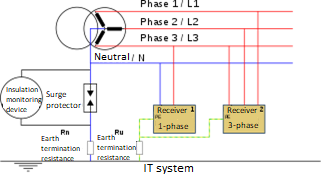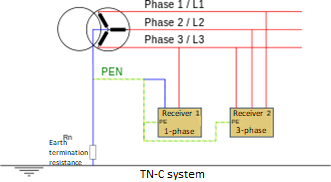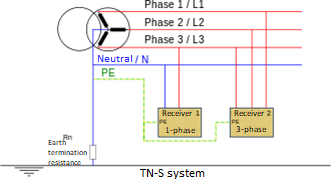In electricity, an Earthing system defines the way the Earth is connected on the voltage source side in comparison to the user mass (metal carcass of devices). Several Earthing systems exist, and the most used are:
| 1st letter: Power source | 2nd letter: Consuming equipment | ||
|---|---|---|---|
| Connected to Earth | T | T | Connected to Earth |
| Connected to Earth | T | N | Connected to Neutral |
| Isolated from Earth | I | T | Connected to Earth |
- TT system: System used in France in private households.
- IT system: Neutral IT system has the neutral of the power source connected to an impedance. It means that it is connected to the ground through a resistor superior to 1000 ohms. Masses are connected to Earth.
- Neutral TN system: This system has the advantage to be economic because there are no differential. But this system has the advantage to be economical beccause there are no differentials. But attention to the installation conditions.
TT system
This system is used in France in private households. They are equipped with a differential global set at 500mA and other differentials set at 30mA and cascaded. It enables to only cut electrically the default part (this is referred to as “selectivity”).

IT system
The neutral point can be connected to the Earth via cables parasitic capacitances, or voluntarily via an impedance of strong value (typically 1 500 Ω). User masses are normally interconnected and connected to the Earth.
It is necessary to use an insulation monitoring device to signal a first default.
See our electrical transformers

TN system
This system is used in installations with low insulation, showing important leakage currents as industrial motors which can create currents superior to 1 Ampere.
There are 3 TN systems:
TN-C
As the default current is only limited by cable impedance, short-circuit intensity is more important. TN-C system is prohibited by the norm NF C 15-100 in premises where there is a risk of fire or explosion. It is also prohibited for networks which have conductors with a section < 10 mm² in Copper or a section < 16 mm² Aluminium.

TN-S
TN system can have Earth and neutral separated (TN-S => “Terre-Neutre Séparé”, Earth-Neutral Separated). TN-S is mandatory for networks which have conductors with a section < 10 mm² Copper or a section < 16 mm² Aluminium.

TN-C-S
There is also a variant TN-C-S which is a mixed TN diagram generally having a TN-C network in the origin of the installation, followed by TN-S networks as for terminal installations.


 Blog
Blog
